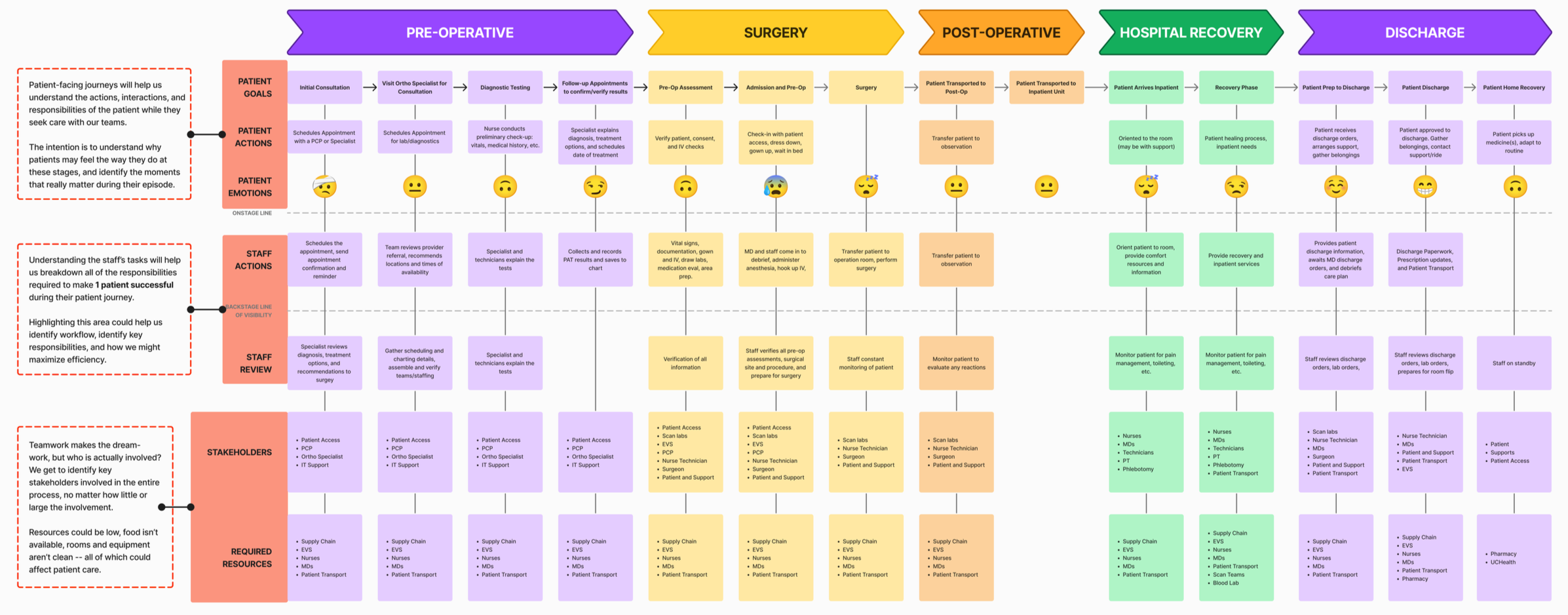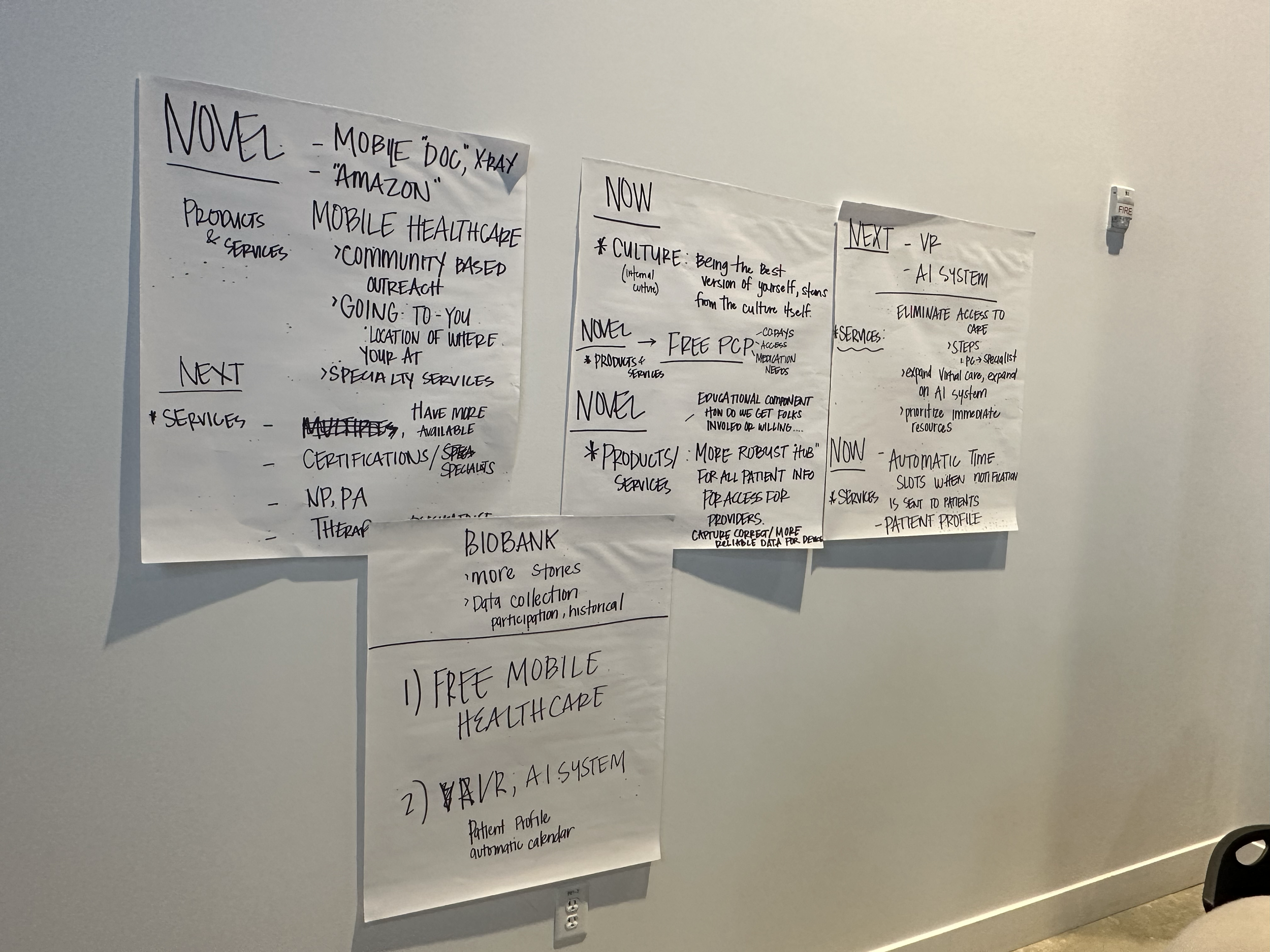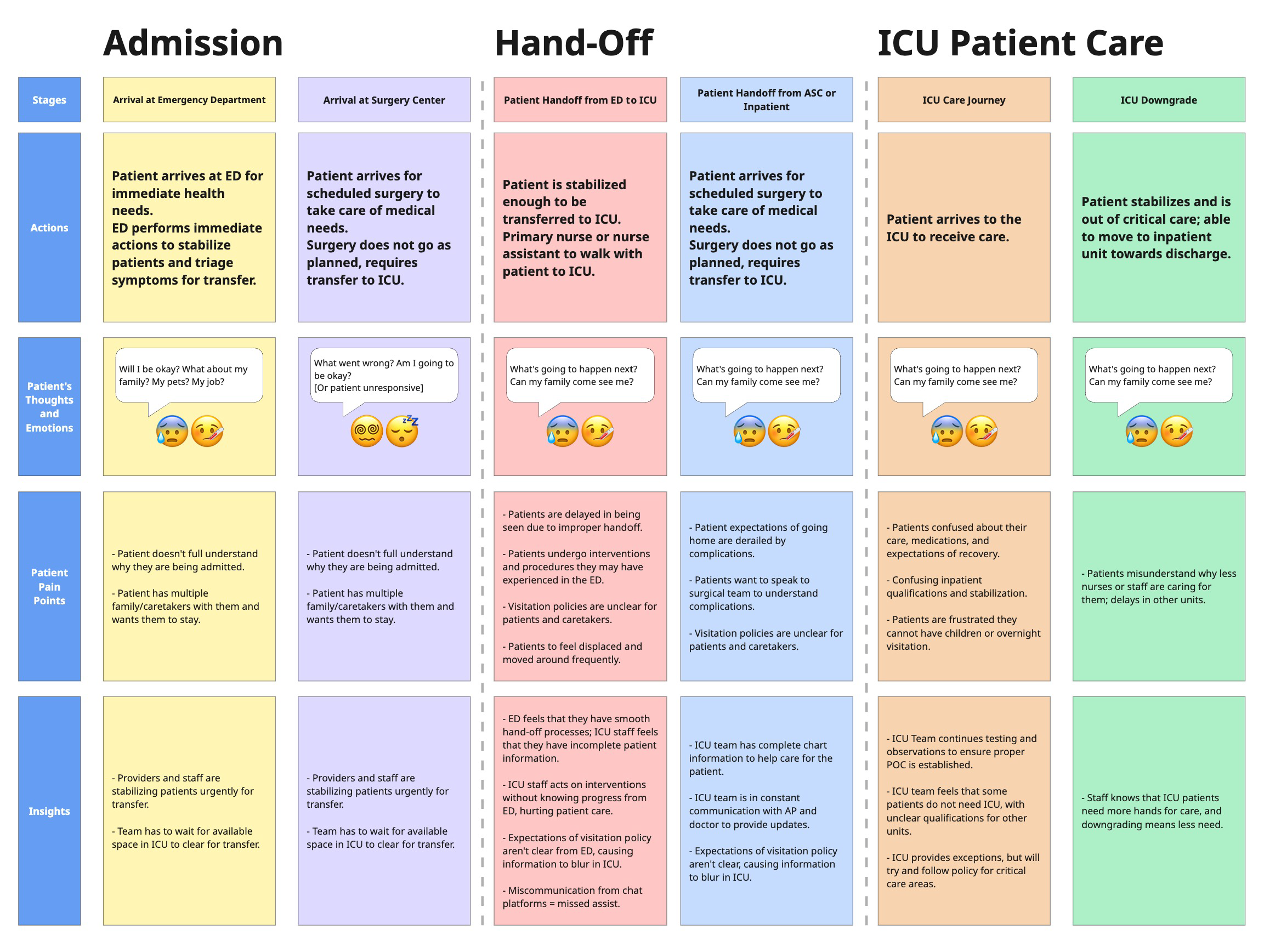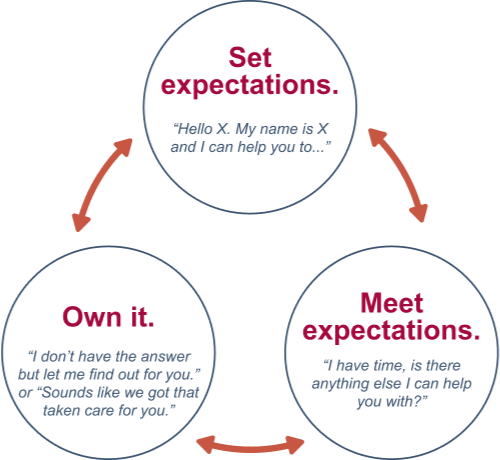
UCHealth -
Set, Meet, Own
PROJECT
ROLE
Experience Designer, Product Designer, Researcher
(User Research, Creating User Personas, Competitor Analysis, Product Structure & Analysis, User Flow, Change Management)
TEAM SIZE
18
ORG SIZE
30,000+
INDUSTRY
Health Care
TIMELINE
Q1 2024 - Ongoing
TOOLS
Wordpress, Figma, Adobe Illustrator & InDesign, PowerBI, Power Apps
PRODUCTS
Service Framework, User-Personas, Experience Hub, System Training
The Experience Framework
The UCHealth Experience team began implementing human-centered design tactics into daily work and innovated the way to approach health care for our community.
As an expansive health care system, we saw opportunity to move our HCAHPS scores into the 90th percentile by identifying the root cause of patient needs. The goal was to create a unified approach for the organization to help us optimize health services across the system to maximize patient outcomes and positively influence patient experience scores, all while meeting the mission of UCHealth – We Improve Lives.
Approach
We developed several assets to support our teams, one of which took shape of an Experience Framework we call Set, Meet, Own, which is a framework that designed by UCHealth to create consistent service across all hospitals and clinics. This idea was created by understanding staff and patient needs with extensive quality research and uncovering powerful themes and insights.
Set, Meet, Own was our approach on how we properly Set Expectations for patients and each other, how we Meet those expectations, and how we Own It. We also knew that when we don’t Set Expectations, others will often create expectations for us. This helped us promote a positive culture around acknowledging daily challenges, creating safe learning spaces, and strengthening our communication with each other and the highest levels of leadership.
Why focus on experience?
Research shows that experience in the health care space ultimately influences patient outcomes – the better the experience, the better the outcome. Data shows that a positive experience can result in fewer mortality rates, a decrease in re-admissions, and an increase in health-seeking behavior for preventative care services, among others, with the reverse also being true.
What contributed to Experience?
The first priority was to understand the needs and goals from the end-users that were impacted the most — our patients. We started with stakeholder maps with the patient at the center and identified key partners.
Now, what was it our patients viewed as elements that impacted their experience? What elements impacted our staff and their ability to meet user needs, and could we find common themes from our most satisfied users to our most dissatisfied users? We developed journey maps, collaborated on building insights and actions, and shadowed staff to fully comprehend challenges. To answer these questions, we conducted the following:
5000+ Patient Rounds
Systematic Quantitative Analysis
(Themes & Trends)
Systemic Qualitative Analysis
(15,000+ Patient Surveys)
100+ Design Sessions
100+ Staff Interviews
Current State Assessments
(Culture & Competencies)
North Star & Strategy
Research found that no matter what the experience with our patients, many if not all, experience fear & anxiety to throughout their entire patient journey. These emotions came from scenarios like first-time hospital experiences, past negative experiences, having their needs met or addressed, how patients expect to return to normal life, and other impactful events from being at a hospital.
How might we use experience to help mitigate fear and anxiety for our patients and our staff?
Our goal became clear.
Strategy
Now, how could we truly impact our community and mitigate fear & anxiety? To address this issue, we partnered with other healthcare partners around Colorado and some out of state, but also a different industry that addressed these same goals, leading us to collaborate with Delta Airlines.
We committed to following every point of the patient journey, from when patients are seeking health care, to the moment they go home and beyond. We found that patients wanted to have confidence that they weren’t forgotten and that their needs we being addressed and met.
Personas
Several personas were developed from our design sessions, interviews with patients, and reviewing workflows with our staff. We wanted to create a level of empathy that could be captured from the patient and staff perspectives. These personas would eventually help us establish a stronger collaborative environment, narrate positive and challenging scenarios for practice, and bring to light our everyday experiences and ways to navigate through our best practices.
And so, a framework was born.
The Experience Framework called Set, Meet, Own, that helped us create expectations and goals for our patients, and goals set by our hospitals and units.
Patients enter our hospitals with some level of fear and anxiety, often from moments of uncertainty, boredom, isolation, and being disregarded. By establishing a framework that can address these emotions, we can set best practices inside and outside of health care by consistently setting realistic expectations, meeting those expectations, and allowing everyone to feel a sense of control and partnership.
Whether we know it or not, we all carry a level of bias that influences our expectations of experience, sometimes creating expectations which we are unable to meet. When clear and reasonable expectations are set, we are better equipped to meet these expectations and ensure that everyone involved has a voice to better collaborate and communicate with each other.
Set, Meet, Own was then transformed into a training kit that was deployed across our system, impacting 14 hospitals and over 200 clinics, supported by design sessions to implement the framework and to build resources around various teams and structures.
Hospitals that received Set, Meet, Own training saw an 8-10% increase in patient satisfaction scores, moving into the 90th percentile on NRC.
Results & Learnings
Patient surveys mentioned less common themes and described more unique, individual experiences from patients and families.
Hospital and unit-based goals were enhanced with stronger communication and collaboration, with an organizational reach of 59%.
At each hospital, we looked at scores and comments prior to our team deploying Set, Meet, Own and recorded common themes and average scores. After looking at these same hospitals three months after deploying Set, Meet, Own, we saw an average
8% - 10% increase in patient satisfaction scores, pushing HCAHPS into the 90th percentile as seen on NRC Health.
Patient surveys also mentioned previous issues like medication communication, responsiveness, and overall communication far less, and commented more on unique experiences. This showed that Set, Meet, Own was able to address common, everyday needs and challenges for patients and create more wholistic experiences.
We understood that each hospital and region would serve different demographics of patients and communities. Set, Meet, Own continued to be a solid foundation to address hospital goals based on patient surveys. Teams also saw a boost in collaboration and team-centered projects; communication between leadership and staff became stronger, learning culture was supported which gave a voice to all staff, and morale and teamwork started to improve amongst teams and leadership. This framework was able to reach 59% of the 33,000 employees through our 10-minute introductory course.
However, it’s not all sunshine - people are resistant to change. To implement the Experience Framework is to change the culture surrounding the current state. The change brings a level of scripting and scenario based training that is not broadly applicable and staff being resistant to new policies. However, we were able to work with some of these individuals as we designed tools around their individual challenges.











